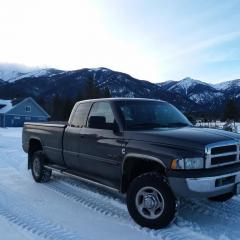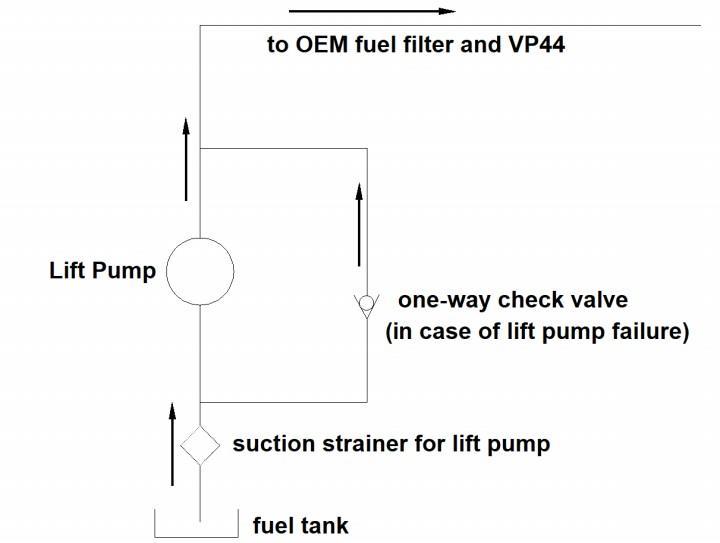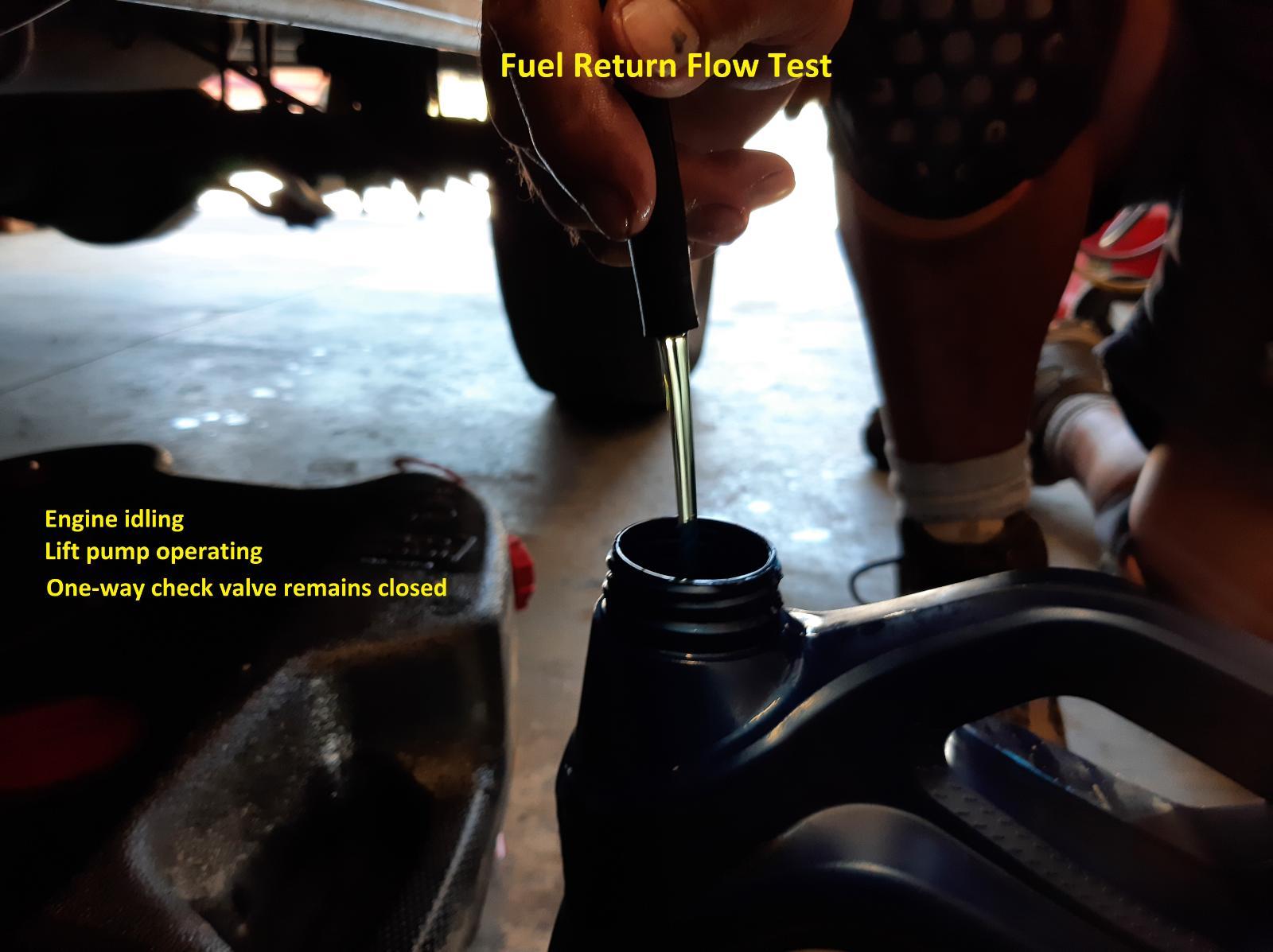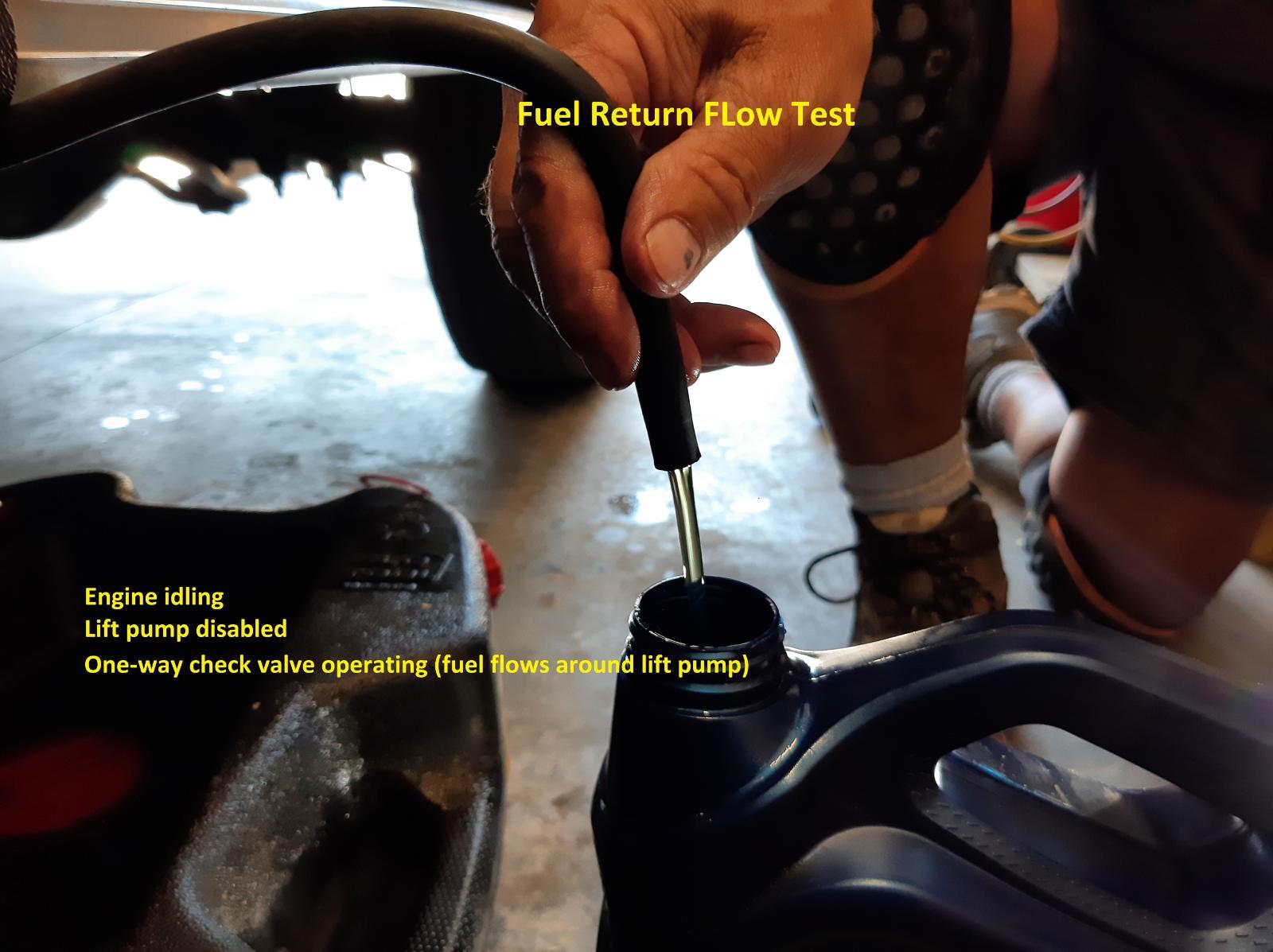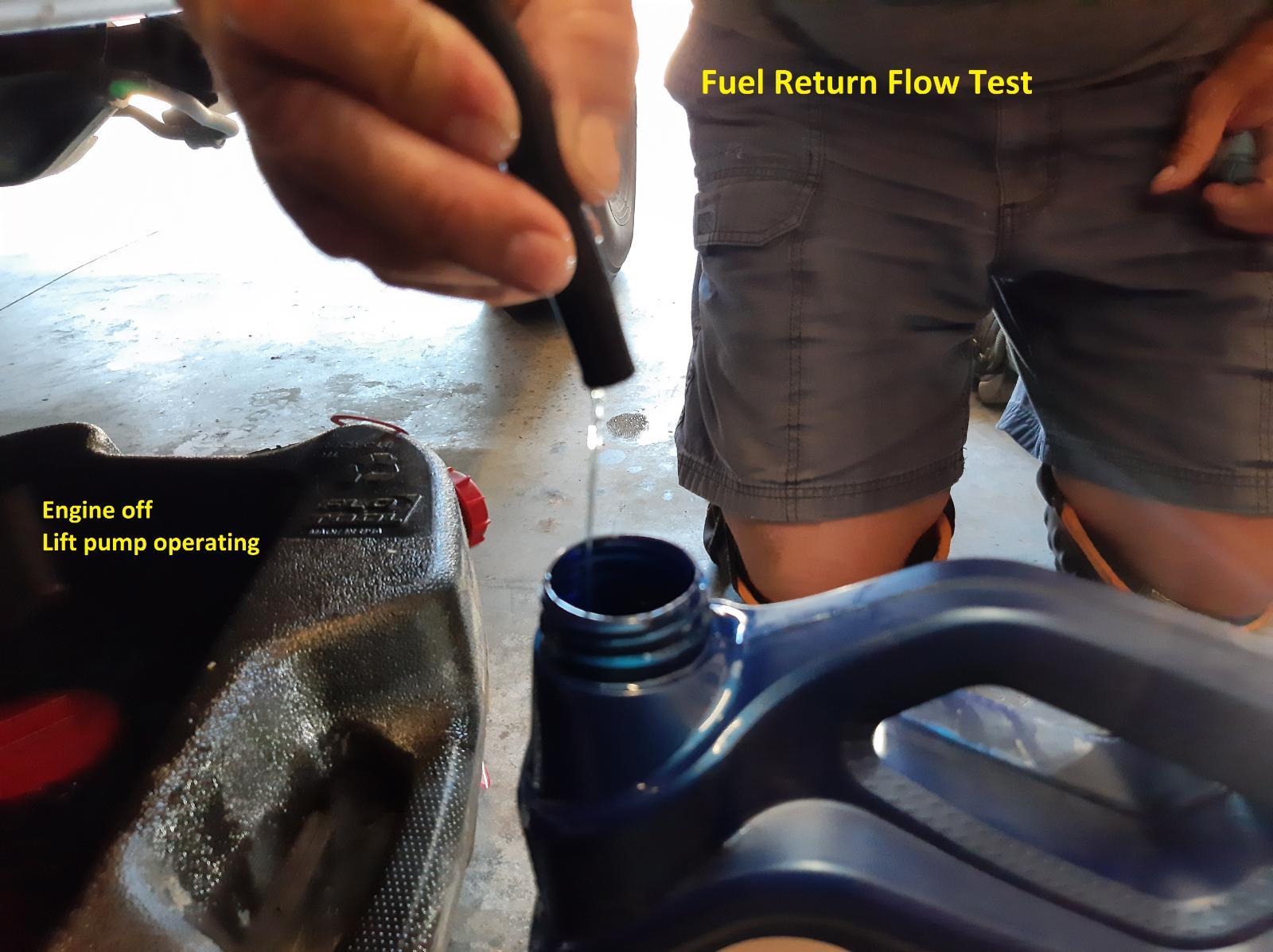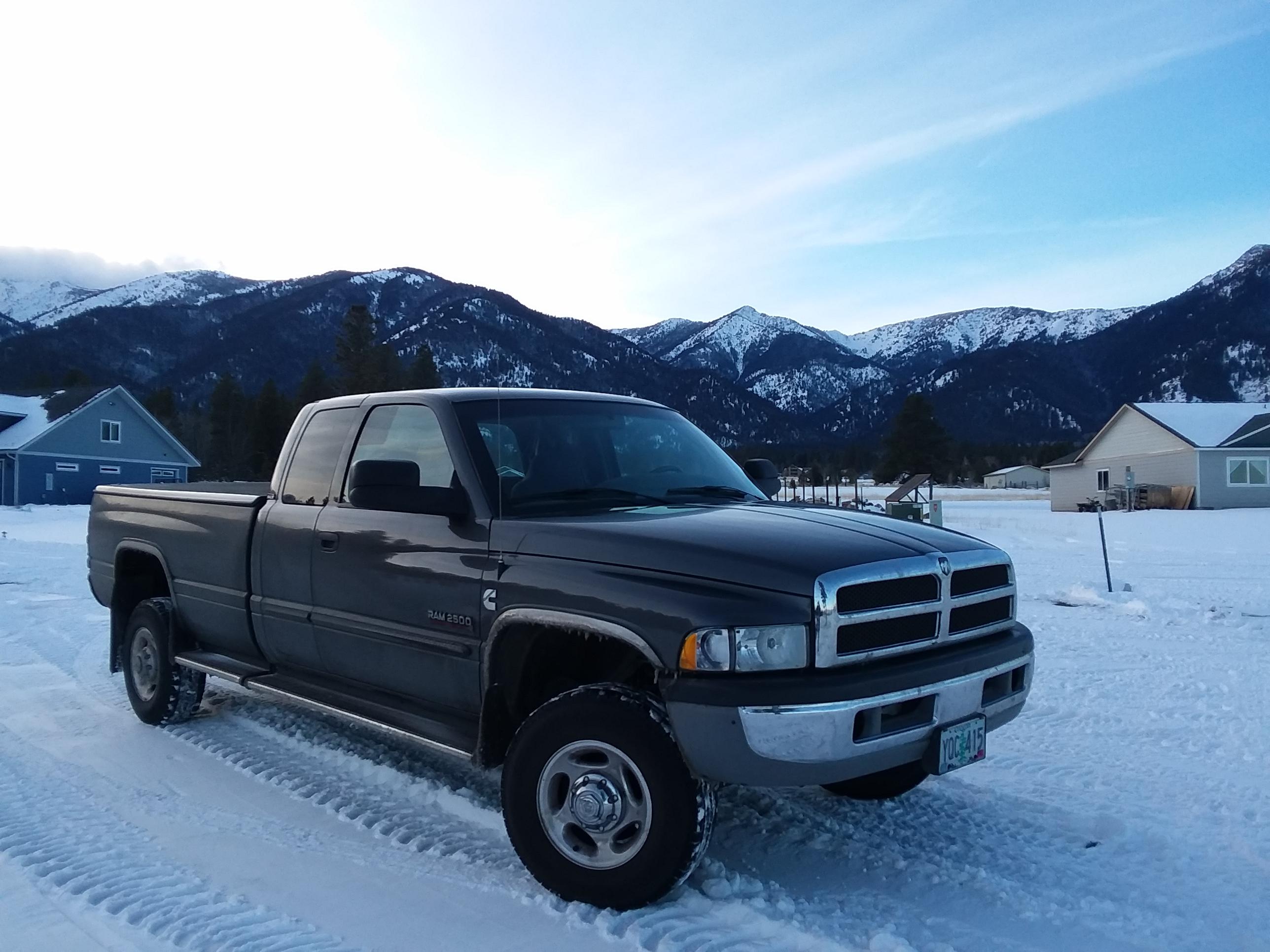
Everything posted by Tractorman
-
VP44 Injection Pump Teardown - How it Works
It could be very possible that "most with a stock lift pump" also have a stock fuel basket which means that hot fuel is being returned right next to the suction in the fuel basket. That alone would make a huge difference in the fuel temperature as the lift pump would be drawing in returned fuel that is much hotter than the rest of the fuel in the tank. If I recall correctly the fuel return line on your truck does not enter the fuel basket. - John
-
VP44 Injection Pump Teardown - How it Works
Just to be clear, I have always believed that there should be a positive pressure at the inlet of the VP44. That is why a lift pump is necessary. The timing piston failed on my original VP44 at 67,000 miles (replaced VP44 at 87,000 mi). The lift pump pressure was always within specifications during that time period. I believe the timing piston failures at that time were due to inferior timing piston and bore material quality because Bosch corrected those issues in their remanufactured VP44 injection pumps without stating to the public that there were issues with them. I appreciate your input. The results of my test show that return flow remains the same regardless of lift pump pressure. - John
-
VP44 Injection Pump Teardown - How it Works
VP44 Injection Pump Fuel Return Flow Test A bit of history – the first VP44 injection pump on my truck failed (code 0216) and was replaced under warranty along with the engine block-mounted lift pump which was also replaced under warranty with an in-tank lift pump in August of 2005 at 87,000 miles. The old block-mounted lift pump was still providing 12 psi at idle and 7 psi at wide open throttle when it was replaced. The new in-tank lift pump provided 6 psi at idle and 3 psi at wide open throttle. I ran that lift pump for 164,000 miles. In April of 2016 at 251,000 miles on the truck, I removed the in-tank lift pump and installed a used FASS DRP-02 frame mounted lift pump. The in-tank lift pump was still working fine – I just wanted the lift pump to be easily accessible if it failed on a road trip. The FASS lift pump provides 12 psi at idle and 6 psi at wide open throttle. Currently, there is approximately 106,000 miles logged on the used FASS DRP-02 lift pump. The current replaced VP44 has logged just under 270,000 miles. As many of you probably know by now, I am a firm believer that the only job for the lift pump is to flow enough fuel to provide a positive pressure at the inlet of the VP44 injection pump under any operating condition. And because I believe this to be true, I have never been concerned about lift pump fuel pressure being low – example: 3 psi at wide open throttle. By design I believe the OEM lift pump produces more flow than the VP44 injection pump and injectors will ever consume under any operating condition which means that there will always be a positive pressure at the inlet of the VP44 injection pump. It is also my understanding that when fuel enters the VP44 injection pump - that fuel flows directly into the inlet of the internal vane pump inside the VP44 injection pump. From this point forward it is the internal vane pump that determines the flow and the maximum operating pressure to provide fuel flow for charging the fill chamber for high pressure injection, fuel flow for hydraulic operation of the timing piston, and fuel flow over the 14 psi overflow valve that returns fuel back to fuel tank for cooling the injection pump. The tests. I have performed several fuel return flow tests from the VP44 fuel injection pump. The purpose for the tests is to show that the volume of fuel returning to the tank (from the VP44 and injectors) does not change whether the lift pump is operating or not operating. To demonstrate this I made one small modification (which will be a permanent modification on my truck) to the supply fuel line. I added a fuel line with a one-way check valve in parallel which bypasses the frame-mounted lift pump. The added fuel line and one-way check valve will allow for free flow of fuel around the lift pump should a lift pump failure occur. During normal lift pump operation the one-way check valve will remain closed. The photo below shows the fuel supply diagram for my truck. For the tests I used a one-gallon oil jug with volume markings at one-quart intervals. I used a helper and started the clock on the 1 quart mark on the jug and stopped the clock on the 3 quart mark on the jug. The total volume returned for each test was .5 gallons of fuel. My truck is a 2002 2500 with a NV5600 transmission. The fuel lines are stock diameter, the fuel filter is the OEM filter inside the filter housing mounted on the engine, and the lift pump is a used frame mounted FASS DRP-02 that probably flows somewhere around 65 GPH. I performed the tests as follows: Test #1: engine at idle, fuel transfer pump operating - .5 gallons pumped in 92 seconds Test #2: engine at idle, fuel transfer pump operating - .5 gallons pumped in 94 seconds Average fuel pumped is .5 gallons in 93 seconds = .3225 gpm rounded to .32 gpm or 19.35 gph Test #3: engine at idle, fuel transfer pump disabled - .5 gallons pumped in 93 seconds Test #4: engine at idle, fuel transfer pump disabled - .5 gallons pumped in 95 seconds Average fuel pumped is .5 gallons in 94 seconds = .3191 gpm rounded to .32 gpm or 19.35 gph Test #5: engine at 2000 rpm, fuel transfer pump disabled - .5 gallons pumped in 64 seconds Fuel pumped is .5 gallons in 64 seconds = .47 gpm or 28.1 gph The averaged test results from Test #1 and #2 (lift pump operating) clearly show that there is no significant volume change when compared to the averaged test results from Test #3 and #4 (lift pump disabled). My conclusion is that lift pump pressure is not relevant to fuel returning from the VP44 injection pump and injectors. The result of Test #5 clearly shows that return flow volume increases with engine rpm, even with lift pump not operating. I performed one other test. Since I am convinced that it is the internal vane pump that does all of the work, I disabled the lift pump and drove my truck to town and back – a 25 mile round trip. I accelerated and held 30 psi boost several times. I restarted the truck several times while running errands. The engine never stumbled and continued to deliver the power it always does. I am not diminishing the importance of the lift pump function, but I will now worry less should I have a lift pump failure while on a trip. I will just keep driving until I get to a convenient place to replace the pump. My overall conclusion is that requiring lift pump pressure to always be above 14 psi or the VP44 injection pump will be sacrificed is now a busted myth. There, I have said it. Of course, each person is entitled to draw his / her own conclusion. One last note…, I know that the VP44 on my truck can fail at any time, but it has already provided a long life, even operating under the parameters of RV275 hp injectors and a Smarty tuner with fuel duration set at 5. I know this will be hard to believe for some, but this VP44 has never seen any lift pump pressure higher than 12 psi, and that 12 psi is only at idle – most of the time it is operating at a far less pressure. The following photos show the volume of fuel returning to tank under specific conditions: - John
-
Uh Oh...wrong oil!
@dripley, I can't believe these guys talk to you like that. I wouldn't do that. I would think it would ruffle your feathers. - John
-
VP44 1998.5 Eyes Burning, Bad Mileage Help
If I was experiencing fumes getting into the cab to the point of making my eyes burn, I would be looking for a an exhaust leak in the engine compartment. A cracked exhaust manifold or leaking exhaust manifold gaskets could cause this. The air intake for the cab ventilation is in the cowling just behind the hood. A cracked in the exhaust manifold can close up as the the engine warms. If the crack is large enough, the turbo could be losing drive pressure, which could account for low engine power. Another source for fumes inside the cab could be engine oil leaking on the exhaust manifold while shut down, then burning off for awhile after the engine is started and the truck is driven. - John
-
front ball joint time
You make a good point here. Portland, Oregon set an all-time high temperature today - 115° - and not even in July or August. The 115° recording was with air at a dewpoint of 51° and 12% relative humidity. So, yes, very hot, but sweat would readily evaporate and cool you. Good example with your drawing. - John
-
Daniel Stern Lighting Sport Headlight Harness
So your truck originally came with a two headlight system and now you have the sport four headlight system? So your returned to you sport four headlight system? Or, your two headlight system? I think you are saying that you tried Daniel Stern's relay harness and this is causing problem with your sport headlight system. If this is so, I would start diagnosing by making sure that the sport headlight system is wired correctly without Daniel Stern's relay harness. That would be: The two outer lights - 9007 bulb (low and high beam filament) both get used. The two inner lights - 9004 bulb (low and high beam filament) high beam only gets used. When low beam circuit is activated, the 9007 low beam filaments are switched on. The 9004 low beam filaments remain off. All high beams remain off. When high beam circuit is activated, the 9007 and 9004 high beam are switched on. All low beams are switched off. Things you may already know: There are separate fuses for left and right headlights. They should be in the power distribution panel. The fuses power the headlight bulbs directly. Wiring from the bulbs (low beam and high beam) goes to the headlight switch and dimmer switch and then to ground. The switches operate in the grounded side of the circuit. I have the sport headlights on my truck and I built my own relay circuit. The system has worked well for years. - John
-
Head Leak
Save yourself some diagnostic time. Pressure check for a coolant leak with a cooling system pressure tester. Perform the test on a cold engine. You will find the exact leak location quickly. - John
-
WHERE TO DRILL A CC/SB 4WD 2500 2001 FUEL TANK FOR A SUMP? WHAT BRAND?
Napa 2790 is the one I purchased. - John
-
Turbo Help
I think you are correct. I think it will perform much better at the higher rpm's. - John
-
Turbo Help
What are the engine rpm's and which gear are you in when you see the 1350°? What are the engine rpm's and which gear are you in when you see the 1300°? What are the engine rpm's and which gear are you in when you see the 1200°? Is your transmission a 5 speed or a six speed? Is the gear vendor in direct drive or overdrive for the above condtions? - John
-
2006 Dodge Adventure!
I had read somewhere some time ago that Dodge did this (not Cummins) for NOX control to come closer to meeting the 2007 emission mandate. I wish I could remember the source. It makes sense to me - a clever inexpensive way to carry over some exhaust gases into the the next intake stroke to reduce NOX emissions without adding on external parts. - John
-
2006 Dodge Adventure!
I believe that the exhaust valve clearance has also changed for that year - from .020 inches to .026 inches for holding back some on the exhaust gases in the cylinder (internal EGR). - John
-
WT mod completed
Mostly depends on the condition of both batteries. - John
-
WHERE TO DRILL A CC/SB 4WD 2500 2001 FUEL TANK FOR A SUMP? WHAT BRAND?
I am glad you edited your post because I was baffled. - John
-
2007 3500 Okay Deal?
I am not an automatic transmission guy. I like six gears that are selectable by me when I say so. But, if I had to buy a newer truck with an automatic transmission, it would NOT be a 4 speed automatic. I agree with @NIsaacs- get a newer truck with a 6 speed auto transmission with an integrated exhaust brake. It would make you wonder why you lived with a 4 speed automatic for so long. I think you would be able to find undeleted newer trucks if that is a concern. - John
-
Vp44 psg removal
@Finlandese and @wil440, thank you for bringing this information to this forum. We here is the USA tend to get tunnel vision and we don't think about the taxes and fees that are imposed on items shipped to your countries. @Finlandese, let us know in a few months how the fix for your truck is doing. - John
-
VP44 Injection Pump Teardown - How it Works
So, If I am understanding correctly, you have two fuel returns entering the basket. Where does your lift pump pull fuel from inside the fuel tank? - John
-
VP44 Injection Pump Teardown - How it Works
@Royal Squire, I don't know the specific size, but the filler neck tee that was recommended to me by @wil440is 1 1/2" and the tee is 1/2". It worked fine on my truck. - John It seems to me that you return fuel flow must not be entering the fuel basket since your fuel temperatures are so low currently. Is the sump a factory setup? There may be no benefit to adding the filler hose tee in your situation if in fact your fuel is being returned in a location other than the fuel basket. - John
-
VP44 Injection Pump Teardown - How it Works
Actually, it is a good question. I really don't think it is an issue. Larger air bubbles would stay at the surface and smaller bubbles would have time to rise to the surface before reaching the suction area. I am sure that fuel sloshing around in the fuel tank while driving down the road generates a certain amount of aeration anyway - probably more than a return line to the filler neck would. Just my opinion, but I think the gains from routing the return line to the filler neck greatly outweigh the risk of problems associated with aeration. - John
-
VP44 Injection Pump Teardown - How it Works
I think you are on to something here. I just recently rerouted the return fuel from the VP44 and head to the filler neck on my truck. Previously it returned into the same basket that the lift pump suction drew from. Before rerouting the fuel return, on road trips I would stop and put my hand of the on the FASS DDRP02 lift pump (modified for a frame mount} and the pump housing would be hot to the touch - I estimated to be about 140 degrees (ambient air temperature was 80 degrees) because I could only hold my hand on it for a few seconds before it became too uncomfortable. This was with a full tank of fuel. Yesterday, I had an opportunity to check the lift pump temperature by my hand with the rerouted fuel return line. I purposely ran the fuel tank down to less that 1/4 tank while towing my trailered tractor over 200 mils at 65 mph - combined weight of 16,000 lbs. I stopped at a rest area just before refueling and placed my hand on the lift pump. Much cooler, probably around 110 degrees with ambient air temperature at 75 degrees. I filled the tank about 10 miles and 30.1 gallons later - the lift pump still running cool just before fill up which means there was only about 5 gallons of fuel left in the tank that was cooling the returned fuel. This test clearly shows the results of simply getting the return fuel flow out of the basket. - John
-
VP44 Injection Pump Teardown - How it Works
You pose a good question. It is the flow from the internal vane pump that is opening the 14 psi overflow valve as soon as the engine is running. Many VP44 industrial engine applications don't even use a lift pump, but you can bet plenty of fuel is returning to the fuel tank while the engine is running. The internal vane pump builds pressure because its flow output is greater than the total consumption of the the fuel being used by the injectors and fuel returning to the fuel tank, The remaining unused fuel is returned directly to the inlet of the internal vane pump through the internal vane pump pressure regulator (8 – 22 bar (116-319 PSI). The 14 psi overflow valve is important for cooling, but because of its location and the narrow passages that supply fuel to it, it does not impact the operating pressure needed to fill the plunger chamber by the internal vane pump. From Jeeper Jimmy: The first thing the incoming fuel sees in the VP44 is a vane-type fuel pump (called by Bosch the ‘Internal Fuel Pump’) which raises the pressure to “8 – 22 bar (116-319 PSI) depending on the application and RPM” (direct quote from VP44 Service Manual and Bosch Fuel Injection Pump Manual). A pressure control valve at the output of the vane pump bypasses fuel back to its input to control the desired vane pump output fuel pressure and varies depending on RPM. This is a pure spring-loaded mechanical devise; it only depends on vane pump pressure, it doesn’t depend on the VP input pressure nor any electrical signal. The amount the pressure control valve opens depends on how much pressure the vane pump is producing. The vane pump is a positive-displacement pump; therefor its output flow increases pressure as RPM increases. From here on, as long as there is a sufficient volume of fuel available at the VP44 input, it doesn’t matter how much pressure the external feed pump (lift pump) is producing, the VP44’s internal pressure will be controlled at design pressure by the vane pump and the pressure regulator. Since the vane pump output pressure increases with RPM, the amount of fuel bypassed varies to allow a desired, controlled pressure which is dependent on engine RPM (the higher the RPM, the higher the pressure). This higher pressure is necessary in a radial piston solenoid valve controlled injection pump (VP44) because the same cavity of the high pressure pump (the Plunger Chamber) must be filled to a design pressure for each injection, unlike the in-line injection pump which fills each of six cavities in sequence. The higher the RPM, the less time there is to fill the Plunger Chamber, therefore the higher the pressure must be to assure proper filling of it prior to the next injection. @Great work!, thank you for your diligence in looking deeper into the internal vane pump and overflow valve operation. - John
-
VP44 Injection Pump Teardown - How it Works
It has been highly recommended, but I never have believed it is true for the reasons I have stated. The fuel circuit is a series circuit. The lift pump feeds directly into the inlet of the internal vane pump. The internal vane pump fills the plunger chamber for the high pressure injection pump. This explanation is simplistic, there is much more going on. It is my understanding that the fuel solenoid cycles rapidly. When it is de-energized, the fuel in the plunger chamber (which is fuel flow from the internal vane pump) is in common with the 14 psi overflow valve providing the fuel return flow. The valve next to the supply inlet is not the overflow valve. It is the pressure regulator for the internal vane pump. See below. Pay close attention to the directional arrows. From Jimmy Jeeper: And that brings us to the Overflow Valve (perhaps the simplest and most misunderstood piece in the VP44).The overflow valve is fed from a separate passageway in the distributor shaft but senses the actual pressure to which the plunger chamber is filled prior to being isolated from the accumulation chamber by the solenoid valve (prior to being pressurized by the high pressure pump). Any excess fuel above the overflow valve set point (about 14 PSI) is returned to the fuel tank by way of the Overflow Valve. The vane pump will always provide more than enough fuel to fill the plunger chamber, therefore there will always be flow back through the overflow valve and, therefore, always cooling flow through the VP44 as long as the engine is running and sufficient fuel volume is available at the vane pump inlet. By design, approximately 70% of the fuel provided by the vane pump will be returned to the fuel tank by the Overflow Valve. Some fuel is also returned to the tank from the injectors. The manual states that “A small amount of fuel is returned from the fuel injectors, while a large amount (about 70% of supplied fuel) is returned from the fuel injection pump”. From Jimmy Jeeper, By design, approximately 70% of the fuel provided by the vane pump will be returned to the fuel tank by the Overflow Valve If an idling engine returns 18 gph and that is 70% of the the internal vane pump flow, then the internal vane pump would be producing approximately 26 gph. The flow would increase to about 78 gph at 2400 rpm. These are just round numbers. Remember, it is unknown how much fuel is being pushed the internal vane pump regulator valve. This would be well within the range of any FASS or Air Dog lift pumps. - John
-
VP44 Injection Pump Teardown - How it Works
I don't see how it could. It is not the lift pump that pushes fuel over the 14 psi overflow valve. The lift pump cannot push fuel through the fixed displacement internal vane pump whether the engine is running or not. The lift pump only charges the inlet of the internal vane pump. It is the internal vane pump that supplies the abundance of fuel immediately as soon as the engine is started. thus supplying a strong return flow of fuel to the fuel tank right away. Here is what we don't know about the internal vane pump: * displacement - cubic inches per revolution (volume of fuel being pumped at a specific engine rpm) * is the pressure regulator valve for the internal vane pump always in operation? If so, what is the volume of fuel being returned to the suction side of the internal vane pump during various engine rpm's? * Here is what we do know about the internal vane pump: * it is a fixed displacement pump which means the volume being pumped is directly proportional to engine rpm. * as soon as the engine is idling the internal vane pump is immediately displacing a specific volume of fuel. * we learned from Mopar-muscle, Apr 24, 2001's fuel return flow test that an idling engine produced 18 gph return fuel flow to the fuel tank. This would mean that the internal vane pump is supplying at least 18 gph. BUT, what we don't know is how much fuel is passing over the pressure regulator valve in the internal vane pump circuit? The return fuel flow will significantly increase as engine rpm increases. If engine rpm is raised from idle (800 rpm) to 2400 rpm, the internal vane pump will triple its volume (it has to because it is a fixed displacement pump). The 14 psi overflow valve is in common with the outlet of the internal vane pump - not the outlet of the lift pump. If the engine is running, fuel is being returned through 14 psi overflow valve. Mopar-muscle, Apr 24, 2001 has shown us this: DD2 , DD TTPM (True Torque Power Module) FP volume idle 11 psi 18gph cruise 8 psi 24gph WOT 2 psi 30gph DD2 , TTPM , HOT PE ANY LEVEL FP volume idle 11 psi 18gph cruise 8psi 24gph WOT 0 psi 30gph - John
-
VP44 Injection Pump Teardown - How it Works
@W-T, these are the results from the test on my truck from my previous post. I have a background in hydraulic fluid power systems and to me the VP44 fuel system has to follow basic hydraulic principles regarding pressure and flow. It is for these reasons I have never been particularly concerned about low lift pump pressure for the VP44 pump on my truck, especially since the replacement VP44 pump has the Bosch fixes already in place. I expect that this 260,000 mile VP44 replacement is nearing the end of its life, and if it is, it has been a good life, but who knows? As for heat soak on the PSG - what about the ECM that is bolted to the side of the engine block? It has proven to be a reliable electronic device under similar heat soak conditions, but nobody seems concerned to the point of adding additional cooling. W-T, I appreciate what you have brought to the forum and I like you style of writing. - John


